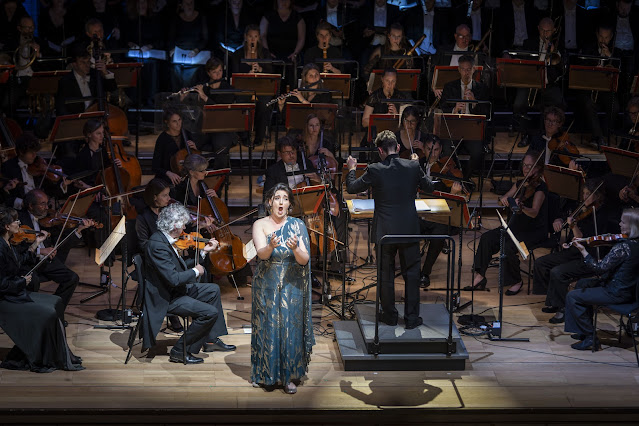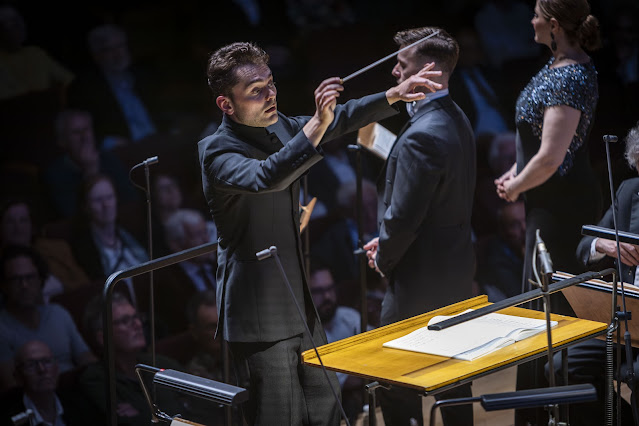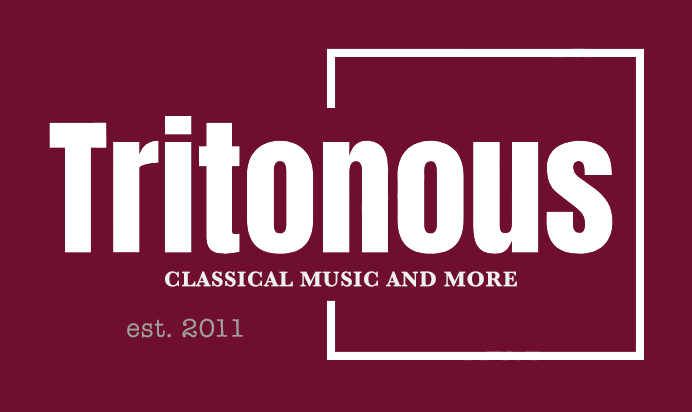 |
| Rossini: Ermione – Beth Taylor (Ermione) – Jakob Lehmann, Orchestra Révolutionnaire et Romantique at Cadogan Hall (Photo: Paul Marc Mitchell) |
Rossini: Ermione (excerpts), Stabat Mater; Ana Maria Labin, Beth Taylor, Hannah Ludwig. Alasdair Kent, Anthony Robin Schneider, Monteverdi Choir, Orchestra Révolutionnaire et Romantique, Jacob Lehmann; Cadogan Hall
Reviewed 2 October 2025
Both sacred and profane Rossini in an evening of extremes from strong operatic emotions, to bouncy quasi-opera buffa solos, all supported by strong, vivid orchestral detail
Thursday 2 October’s concert at Cadogan Hall was billed as the start of a new collaboration between conductor Jakob Lehmann [see my recent interview with him] and the Orchestra Révolutionnaire et Romantique exploring historically informed Rossini. For this first event, rather than a complete opera, we heard substantial excerpts from Rossini’s 1819 opera seria, Ermione alongside his Stabat Mater from 1842. It worked, because Ermione is one of Rossini’s most serious, neo-classical operas whilst the Stabat Mater leavens its seriousness with a perkiness that is rather operatic.
Jakob Lehmann, the Monteverdi Choir and the Orchestra Révolutionnaire et Romantique were joined by soloists Ana Maria Labin, Beth Taylor, Hannah Ludwig, Alasdair Kent, Anthony Robin Schneider with soloists from the choir, Angharad Rowlands, Elinor Rolfe Johnson, Xavier Hetherington and Marcus Swietlicki. The scenes from Ermione were done off the book with an minimal element of staging, director Thomas Guthrie.
 |
| Rossini: Stabat Mater – Alasdair Kent, Ana Maria Labin – Jakob Lehmann, Orchestra Révolutionnaire et Romantique at Cadogan Hall (Photo: Paul Marc Mitchell) |
With a full chorus and orchestra, it was a remarkably busy stage giving the singers a relatively narrow strip at the front. We began Ermione and the overture introduced us to its remarkable sound world. Ermione was one of a sequence of operas Rossini wrote for Naples where the lavish facilities and ample rehearsal time meant that he was able to explore and experiment. His operas there included spectacular scenic effects (Moise in Egitto) and complex ensemble scenes with multiple choral groups (La donna del lago) of the type we now take for granted. Ermione pushed other boundaries as Rossini paid more attention to text and dramatic situations. There are few crowd-pleasing moments and the title character’s final mad scene eschews the standard operatic forms of the day to create something more striking. It was not a success, so much so that Rossini rather than trying to salvage it, reused the music.
The overture, which includes the off-stage male chorus (here on-stage) was a mix of strong drama and vivid detail. Throughout the opera, Lehmann’s approach to the music brought out the strength of Rossini’s musical framework and for all the elaborate vocal detail, there was something neo-Classical, almost sculptural about the music. The opening chorus proper was strong and serious, with focused intensity from the choir and a mix of hard edges and fine detail in the orchestra.
Hannah Ludwig was impressively fierce as Andromaca, projecting her opening scene with compelling focus. Her cavatina featured an expressive use of register changes, with focus on a strong lower register yet with fine filigree upper notes. This was ornament as an expressive tool rather than just for show. Her caballeta displayed real fire, with Ludwig projecting the character’s fierceness and control. The smaller roles of Cefisa, Attalo and Fenicio (Anghard Rowlands, Marcus Swietlicki, Anthony Robin Schneider) provided fine support.
We then jumped to the second scene of the opera for something lighter, a delightful celebratory chorus and aria with Elinor Rolfe Johnson on delightfully bouncy form as Cleone. But the real highlight of this scene was the opening with its fabulously raspy horns (all four of them).
%20c.%20Paul%20Marc%20Mitchell.jpg) |
| Rossini: Ermione – Alasdair Kent (Oreste), Xavier Hetherington (Pilade) – Jakob Lehmann, Orchestra Révolutionnaire et Romantique at Cadogan Hall (Photo: Paul Marc Mitchell) |
The scene for Oreste (Alasdair Kent) and Pilade (Xavier Hetherington) is typical Rossini in the way he extends what is a traditional double aria for Oreste into something more, both by stretching the music but also by including Pilade as an active participant in the drama. Oreste is here conflicted, he loves Ermione (who does not love him) and is supposed to ensure she marries someone else. We began with strong drama in accompanied recitative where the two men’s elaborate lines projected strong emotion. Kent’s account of Oreste’s cavatina was fearless. The role goes alarmingly high (it was written for Giovanni David who created several such role for Rossini) yet Kent weaved this into the whole, approaching the peaks in the right spirit. And then his cabaletta featured some insanely fast passagework. Hetherington’s Pilade got to show off too, but only ever in a supporting role yet Hetherington gave as good as he got in the dramatic interchanges.
But the focus of the excerpts was scenes two and three from Act Two, where Ermione (Beth Taylor) struggles with the fact that Pirro does not love her and is marrying Andromaca. Ermione persuades Oreste to kill Pirro, saying she will then marry him, but is wracked with remorse. The two scenes have Ermione on stage at all time and push the character through a series of extreme emotions. Rossini’s music does not aim for crowd-pleasing show, this is ultimate drama 1819 style. Lehmann supported the whole with strong orchestra gestures and fine detail.
The scenes began with a terrific face off between Beth Taylor’s Ermione and Hannah Ludwig’s Andromaca, though alas Andromaca leaves the stage early. Like Ludwig earlier, Taylor made great use of her lower registers, using change in register as a means of colouring the vocal line and switching emotion up a gear. Yet there was delicacy too. When she sang of her love for Pirro, the aria was elaborate yet moving. Perhaps more striking was the moment when she reacted to hearing the off-stage wedding march for Andromaca and Pirro, with Taylor projecting stylised dramatic statements over the strong orchestral contribution.
 |
| Rossini: Ermione – Elinor Rolfe Johnson (Cleone) – Jakob Lehmann, Orchestra Révolutionnaire et Romantique at Cadogan Hall (Photo: Paul Marc Mitchell) |
When Alasdair Kent’s Oreste and the chorus appeared, Rossini introduced the crescendo passage from the overture, but there was no bouncy fun here. This was strong emotions, compelling drama and vocal spectacle. The scene ended with Taylor’s vivid outpouring of emotion in a fast, bravura aria as Ermione has just sent Oreste off to kill Pirro. This brought Rossini’s Gran Scena Ermione to a conclusion though frustratingly we did not get to hear the opera’s final scenes.
This hour of music from the opera was a wonderful taster for the full thing, and I was impressed by the way the singers were able to conjure the characters and strong emotions from a few scenes. Orchestrally, the mix for strength and delicacy was particularly noticeable. There were lots of individual instrumental highlights and in many places the complexity of Rossini’s orchestral writing was matched by a fine array of timbres and textures.
Rossini began his Stabat Mater in 1831, two years after his final opera William Tell. The first version of the Stabat Mater featured half Rossini and half a friend, Giovanni Tadolini. When a publisher wanted to print it, Rossini hastily wrote the remaining parts so that the version performed in 1842 is all him. This was over 20 years before the Petite Messe Solennelle but that work’s fascination for large-scale counterpoint is still present along with a rather sly nod to operatic textures.
For this performance the soloists were Ana Maria Labin, Hannah Ludwig, Alasdair Kent and Anthony Robin Schneider. The Introduzione began deep and dark with Rossini’ extending the movement into something complex involving both chorus and soloists. This was Rossini at his most serious and academic. Yet the following tenor aria is notorious for its bouncy jollity. Alasdair Kent managed to imbue the aria with real emotion and Lehmann’s orchestra gestures were strong, but that perky bounce was still opera buffa Rossini. After some fabulous playing from hand-stopped horns, the duet from Ana Maria Labin and Hannah Ludwig gave us two contrasting operatic voices full of rich character, with some superbly elaborate duet moments. Having played a supporting role in the first half, Anthony Robin Schneider came into his own with voice displaying both warmth and amplitude, along with a great sense of line in his solo, followed by the striking unaccompanied chorus with bass recitative.
 |
| Rossini: Stabat Mater – Ana Maria Labin, Hannah Ludwig, Alasdair Kent, Anthony Robin Schneider – Jakob Lehmann, Monteverdi Choir, Orchestra Révolutionnaire et Romantique at Cadogan Hall (Photo: |
The ‘Sancta Mater’ quartet was fast and perky, we were definitely back in opera land and Lehmann really built the excitement. This lead to a strong solo from Ludwig in her cavatina, again exploiting fine chest colours. Similarly, Labin was on strong form in her cavatina, bringing in striking contrasts of tone. Perhaps the most daring movement, however, is the penultimate one where Rossini write an extended unaccompanied ensemble for the four soloists. Here they were terrific, and there were no tuning issues as Lehmann launched that amazing final chorus.
The blog is free, but I’d be delighted if you were to show your appreciation by buying me a coffee.
Elsewhere on this blog
- Explaining the unexplainable: a magical album from Lotte Betts-Dean, Dimitris Soukaras, everything you’ve ever lived on Delphian – record review
- Clarinet & strings: Coleridge-Taylor & a new Jago Thornton piece from Sacconi Quartet & David Campbell at Conway Hall – concert review
- Letter from Florida: Tianyi Lu conducts Bartók & Brahms with Lukas Vondracek & New World Symphony – concert review
- Engaging rom-com energy: Martin Constantine’s production of Donizetti’s The Elixir of Love at English Touring Opera – opera review
- La Grande Audition de Leipzig: Paul Agnew & Les Arts Florissants take us to Leipzig in 1722 & 1723 – concert review
- One little book sitting in a convent: Laurie Stras introduces the background to Musica Secreta’s new recording of music from the Biffoli-Sostegni manuscript – interview
- A declaration of love to a composer: pianist Vanessa Wagner on Philip Glass’ Etudes – feature
- Iphigenia in Blackheath: community opera dares to go where few UK companies do with a compelling account of Gluck’s French tragedy – review
- A very fresh, summer album: Hummel & Bertini from Sestetto Classico on MDG – record review
- Home








